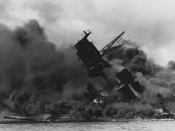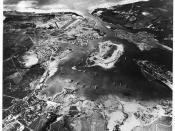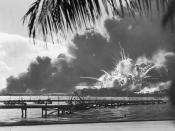On December 7, 1941, the Japanese attacked the United States naval station and its associated air defense bases at Pearl Harbor in Hawaii. This disaster could have occurred for several reasons. Japanese decoded messages made it clear that war was imminent. It was the fault of the United States government for not providing adequate information to commanders in Hawaii detailing Japan's intentions. However, it was equally the fault of the local commanders at Pearl Harbor for not acting on whatever information they were provided. The overall cause of the attack on Pearl Harbor was a combination of mutual confusion and miscalculation between government officials in Washington and local commanders at Pearl Harbor.
The war warnings to Admiral Kimmel, Commander at Pearl Harbor, and other commanders were insufficient attempts of preventing a Japanese attack. Because Hawaii is located so far from Japan, few believed an attack on Pearl Harbor possible. However, Japan was becoming increasingly aggressive and negotiations with the Unites States had ceased (Doc.
A). Admiral Kimmel blamed the government for depriving the Pacific Fleet of a chance to avert the forthcoming disaster. Also, he was not informed about a local FBI report indicating suspicious activity near Pearl Harbor naval base. Although a "war warning" dispatch was sent to the Pacific, it did not indicate the possibility of an attack on American property. The message simply ordered an appropriate defense deployment against Japan, not specifying the location of the attack. The lack of defense by commanders in Pearl Harbor and the vague orders given by the government created an easy target for Japan (Doc. F).
The United States government expected the local commanders to be fully aware of a surprise Japanese attack. The government assumed that all the necessary procedures were being taken at Pearl Harbor to make sure...


